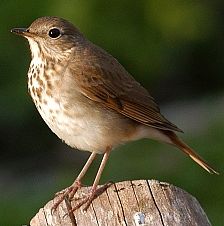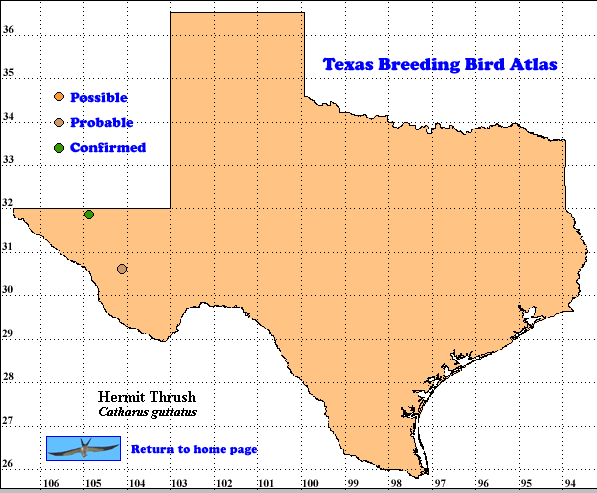The Hermit Thrush is a taxon in need of considerable further study. Three broad populations are generally recognized, varying in color, size and plumage pattern: Pacific lowlands, western interior montane and eastern (or northern) groups. The total number of recognized subspecies varies from 7 (Am. Ornithol. Union 1957) to 13 (Pyle 1997). While the geographical breeding ranges of these three groups are fairly well defined, the boundary between the first and second needs further research. The subspecies need much further work as plumage and breeding range differences are not sharply defined and winter ranges of groups and subspecies need extensive further work. Texas is listed as part of the winter range of at least 2 groups and 4 subspecies. Hermit Thrushes breeding in the Trans-Pecos mountains apparently belong to the western interior montane group (Jones and Donovan 1996, Pyle 1997).
DISTRIBUTION. During the 1987-1992 field work seasons of the TBBA project, observers found one confirmed and 6 possible breeding records in latilong 31104, quad H7 and a probable record in quad H8 (in the Guadalupe Mountains) and 2 probable and 1 possible records in 30104 quads F1 and F2 in the Davis Mountains.
In other parts of North America, Hermit Thrushes breed from Manitoba across southern Canada and the north midwestern United States to Newfoundland, New England and the Appalachian Mountains south to West Virginia. In the western United States and Canada other races breed in the Rocky Mountains and along the Pacific Coast from Alaska to Baja California. In winter this thrush is found in the southeast United States and west through Texas to the Pacific Coast from Washington south to the tip of Baja California. The species also winters in mainland Mexico south to the Isthmus of Tehuantepec and in the highlands of Chiapas, Mexico and Guatemala (Howell and Webb 1995, Jones and Donovan 1996, Sauer et al. 2005).
SEASONAL OCCURRENCE. Migrant and winter resident Hermit Thrushes arrive in Texas as early as September 10 with most coming between late October and late November. These birds have left the state by mid-May. Migrants are common in Texas. In winter the species is common except in the Trans-Pecos, Panhandle and South Plains where Hermit Thrushes are rare to uncommon (Oberholser 1974, Lockwood and Freeman 2004). Data is not available on the Texas breeding period, but in Arizona almost all breeding records were obtained in June and July (Spence 2005) .
BREEDING HABITAT. In Texas Hermit Thrushes breed at high elevations in the Davis and Guadalupe mountains among pine, Douglas fir and oak (Oberholser 1974). In Arizona about 62% of breeding records came from mixed conifer and pine-oak habitats (Spence 2005) and in Colorado, 74% of graphed habitats were coniferous (Yaeger 1998).
In contrast to eastern Hermit Thrushes which generally nest on the ground western thrushes generally place their nest in a conifer or other tree or bush 1-3 m (3-10 ft) above ground. The large, well-constructed structure is built by the female of moss, coarse grasses, plant stems and bark and lined with fine grasses, rootlets and hair. The outside diameter is 13 cm (5 in), height 5-9 cm (2-3.5 in), inside diameter 6.5-7 cm (2.5-2.8 in) and cup depth 3.8-5 cm (1.5-2 in; Harrison 1979, Jones and Donovan 1996)).
The female usually lays 4 (western races) smooth, pale blue, usually unmarked eggs which she incubates for 12 (range 11-13) days. Nestlings fledge at 12 (range 10-15) days after hatching. Second successful broods are rare, but Trans-Pecos breeders need further study. The rate of parasitism by Brown-headed Cowbirds (Molothrus ater) appears relatively low (<5%; Harrison 1979, Jones and Donovan 1996).
STATUS. Hermit Thrush is another of the many species breeding in Texas only in the Trans-Pecos mountains. Since Oberholser’s 1974 book appeared, breeding has been detected in the Davis Mountains (Lockwood and Freeman 2004) and these authors rate this thrush as an uncommon summer resident in these two ranges.The population appears to disperse to lower elevations after breeding.
Although the North American Breeding Bird Survey does not sample this thrush in Texas, data from all 473 routes in western states and provinces suggest a yearly population change close to 0% (Sauer et al. 2005).
Text by Robert C. Tweit (2007)
Literature cited.
American Ornithologists’ Union. 1957. Checklist of North American birds, 5th ed. Am, Ornithol. Union, Washington, DC.
Harrison, H. H. 1979. A field guide to western birds’ nests. Houghton Mifflin, Boston, MA.
Howell, S. N. G. and S. Webb. 1995. A guide to the birds of Mexico and northern Central America. Oxford University Press, New York.
Jones, P. W. and T. M. Donovan. 1996. Hermit Thrush (Catharus guttatus). In The birds of North America, No. 261 (A. Poole and F. Gill, eds.). The Birds of North America, Inc., Philadelphia, PA.
Lockwood, M. W. and B. Freeman. 2004. The TOS handbook of Texas birds. Texas A&M University Press, College Station.
Oberholser, H. C. 1974. The bird life of Texas. University of Texas Press, Austin.
Pyle, P. 1997. Identification guide to North American birds, part 1. Slate Creek Press, Bolinas, CA.
Sauer, J. R., J. E. Hines, and J. Fallon. 2005. The North American Breeding Bird Survey, results and analysis 1966-2005. Version 6.2 2006. USGS Patuxent Wildlife Research Center, Laurel MD < http://www.mbr-pwrc.usgs.gov/bbs>
Spence, J. R. 2005. Hermit Thrush (Catharus guttatus). In Arizona breeding bird atlas. pp. 438-439 (T. E. Corman and C. Wise-Gervais, eds.). University of New Mexico Press, Albuquerque.
Yaeger, M. 1998. Hermit Thrush (Catharus guttatus). In Colorado breeding bird atlas, pp. 394-395 (H. E. Kingery, ed.). Colorado Bird Atlas Partnership, Denver.

